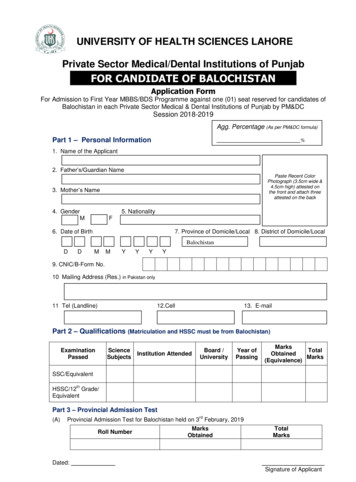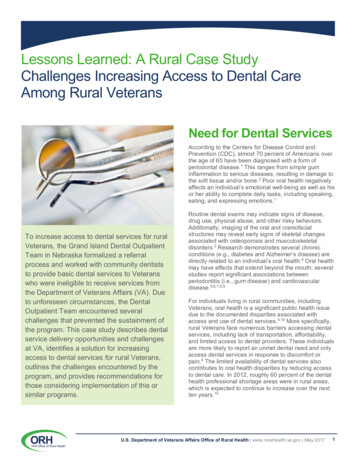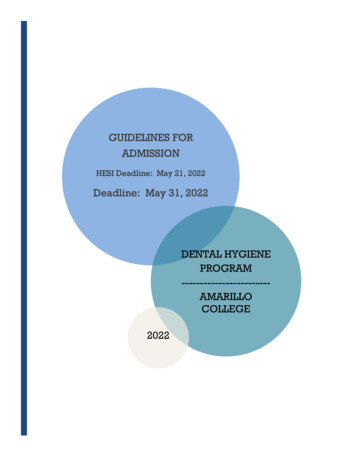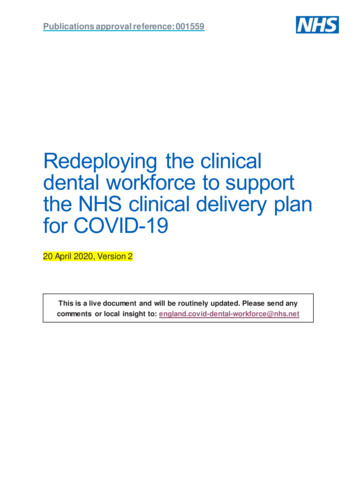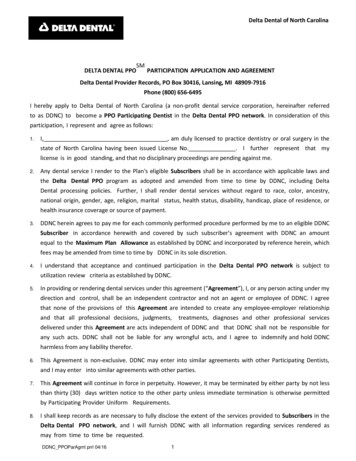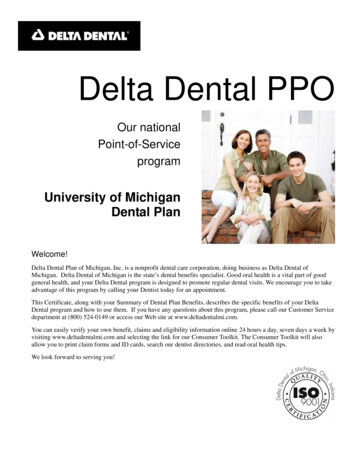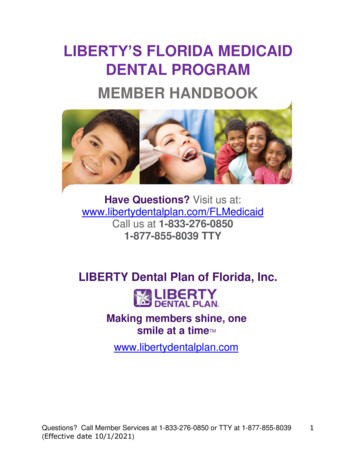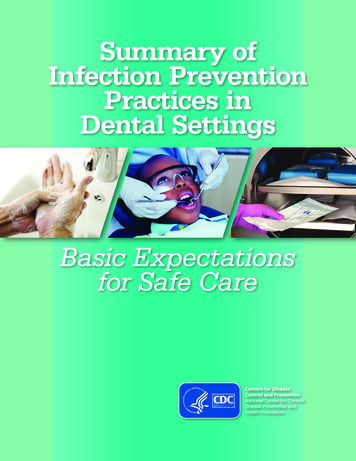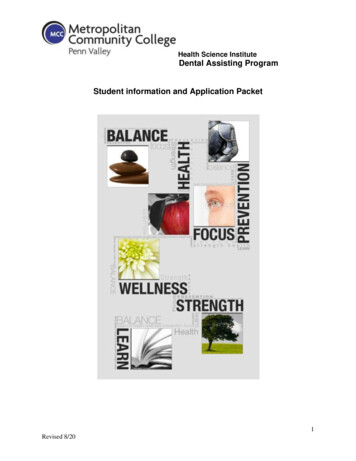
Transcription
ACCESS TODENTAL TECHNOLOGYReducing Barriers to Licensure and Employmentin Dental TechnologyNational Essential Competencies for Dental Technology Practice in CanadaApril 2019Funded by the Government of Canada’sForeign Credential Recognition Program
National Essential Competencies for Dental Technology Practice in Canada, 2019Canadian Alliance of Dental Technology Regulators (CADTR)IndexIntroduction . . .3Competencies . 8Core Competency Units . 8Unit 1: Foundational Knowledge . . . . .8Unit 2: Environmental Safety and Use of Laboratory and Equipment . . .10Unit 3: Design, Fabrication, and Repair of Dental Technology Prostheses and Appliances .12Unit 4: Accountability and Professionalism. . .14Functional Competency Units . .16Unit 5: Patient Care . . . .16Unit 6: Leadership, Business Management, and Administration . 18Unit 7: Oral and Maxillofacial Surgery and Complex Orthodontics . . 20Glossary . . .21Page 2
National Essential Competencies for Dental Technology Practice in Canada, 2019Canadian Alliance of Dental Technology Regulators (CADTR)IntroductionThe Canadian Alliance of Dental Technology Regulators (CADTR) is the national federation of dental technology regulators in Canada.It is comprised of seven (7) of the eight (8) regulatory bodies that have been established and mandated by their respective provincialgovernments to regulate the practice of dental technology. CADTR includes the following organizations: College of Dental Technicians of British Columbia;College of Dental Technologists of Alberta;Dental Technicians Association of Saskatchewan;College of Dental Technologists of Ontario;Ordre des techniciens et techniciennes dentaires du Québec;New Brunswick Dental Technicians Association; andNova Scotia Dental Technicians Association.The profession of dental technology is also regulated in Newfoundland and Labrador, but it is not yet regulated in Manitoba, PrinceEdward Island, Yukon, Northwest Territories, or Nunavut.The CADTR regulators have a mandate to serve and protect the public and they fulfill this role by, among other means, ensuringindividuals seeking registration to practise dental technology meet standard qualifications in education and professionalcompetence. CADTR focuses on national issues of concern and on advancing the profession of dental technology. It operates as aforum for the exchange of information between regulating bodies to assist them in fulfilling their mandates.In 2018, CADTR initiated the Access to Dental Technology (ADT) project, funded by the Government of Canada’s Foreign CredentialRecognition Program. One component of this project included the revision of The Competency Profile for Canadian DentalTechnicians/Technologists (2010). The competency revision initiative was led by a CADTR – ADT Steering Committee and was acritical first step in creating a harmonized registration process across Canada.Page 3
National Essential Competencies for Dental Technology Practice in Canada, 2019Canadian Alliance of Dental Technology Regulators (CADTR)The completed competency revisions are based on the results of an environmental scan, literature reviews, and stakeholderconsultations. The CADTR Board approved the National Essential Competencies for Dental Technology Practice in Canada, 2019 (theEssential Competencies), for national implementation.Where differences exist between the Essential Competencies and the practice of dental technology as defined by a regulatoryauthority in an individual jurisdiction, the jurisdictional requirements or limitations take precedence.CompetenciesThe Essential Competencies outline the knowledge, skills, and attitudes required for dental technology practice in Canada. TheEssential Competencies are overarching, validated standards of practice for dental technologists/technicians and provide astructured guide to help identify, evaluate, and develop the behaviours required for entry-level practice and continuingcompetence. 1Purpose of the Essential CompetenciesAn Essential Competencies document is used for many reasons, including to: Provide the foundation for the entry-level examinations; Support education programs by informing curricula; Provide guidance and direction to professionals within practice settings; Establish the minimum expectations for regulation; and Provide the foundation for professional development and continuing competence assessment tools.While initially created to assist the dental technologist/technician to better understand professional expectations for themselves,the Essential Competencies document also helps the public to understand what they may expect from dentaltechnologists/technicians. Nationally recognized and applied essential competencies also aid regulators with the harmonization oftheir approaches to the above-noted aspects of professional regulation, including making legally required provisions for labourmobility.1Marrelli AF, Tondora J, Hoge MA. “Strategies for developing competency models.” Adm Policy Ment Health. 2005;32(5-6): 533-561.Page 4
National Essential Competencies for Dental Technology Practice in Canada, 2019Canadian Alliance of Dental Technology Regulators (CADTR)Competency DevelopmentThe Essential Competencies was developed using the Delphi Study methodology 2. The Delphi study included several rounds of focusgroups with dental technologists/technicians (both Canadian- and internationally educated), dental technology education programeducators, and members of the CADTR – ADT Steering Committee.The goal of the Delphi process was to systematically facilitate communication of information via several stages, including theconsultant asking questions, undertaking analysis, providing feedback, and asking further questions to develop and validate thecompetency and performance indicators. Additionally, a national online survey was circulated in both English and in French toregistered dental technologists/technicians. Data was collected on opinions about the relevance of the competencies andperformance indicators, and respondents were asked to assess their importance to practice and the public interest.The validation of the Essential Competencies involved eight key steps:1. Literature review and global environmental scan of essential competencies and competency profiles;2. Review of the different legislated scopes of practice, as defined in the Canadian provincial dental technology profession’slegislation and regulations;3. Gap analysis of the Competency Profile for Canadian Dental Technicians/Technologists (2010);4. Development of the competency framework outline, with dental technology program educators;5. Competency writing sessions with national representation from practising dental technologists/technicians and dentaltechnology program educators;6. Stakeholder consultations with the CADTR – ADT Steering Committee, dental technology program educators, and practisingdental technologists/technicians;7. Administration of a national validation survey; and8. Finalization and approval by the CADTR Board.Competency FrameworkCADTR recognizes that regulation of the practice of dental technology varies by province and is dependent on legislated scope ofpractice and registration class and category. Therefore, it is important to understand that the Essential Competencies focus on theattributes of the fully licensed dental technologists/technicians practice, and that the competencies have been divided into twocategories: Core Competencies and Functional Competencies.2Emergency Nurse Association Nurse Practitioner Validation Work Team. “Nurse Practitioners’ Delphi Study: Competencies for Practice in Emergency Care.”Jenonline.org. 2010;36(5): 439-449.Page 5
National Essential Competencies for Dental Technology Practice in Canada, 2019Canadian Alliance of Dental Technology Regulators (CADTR)Core competencies are defined as competencies demonstrated by competent and ethical professionals, no matter their areas ofpractice, years of experience, or role.3 Functional (role- specific) competencies include the knowledge, skill, and judgement requiredto perform a specific role or job, or to work in a specific area of practice.4 The Essential Competencies builds upon and expands TheCompetency Profile for Canadian Dental Technicians/Technologists (2010), and is supported by specific competency units, additionalcompetencies, and performance indicators that enhance the depth and breadth of each identified competency.The Essential Competencies uses a three-tier hierarchy framework comprising units, competencies, and performance indicators, asthe diagram below indicates.Competency Defines an area in which someone performs in their role. Defines major core and functionality areas of practice and tasks.UnitCompetenciesPerformanceIndicators Describes the identifiable compents of expected performance (knowledge, skill, judgment and attitudes). Describes the overall expection. Describes inter-related sets of behaviours for each competency. Provides the criteria that define the level of expectation.3Lenburg.C, et al. “THE COPA MODEL: A Comprehensive Framework Designed to Promote Quality Care and Competence for Patient Safety.” Nursing Ed. 2009.30;5: 312-317.4University of Baltimore. “Guide for Writing Functional Competencies.” 2005.Page 6
National Essential Competencies for Dental Technology Practice in Canada, 2019Canadian Alliance of Dental Technology Regulators (CADTR)In the Essential Competencies, 34 competencies are organized into 7 competency units (4 core and 3 functional) as follows:Core Competency UnitsUnit 1: Foundational KnowledgeUnit 2: Environmental Safety and Use of Laboratory and EquipmentUnit 3: Design, Fabrication, and Repair of Dental Technology Prostheses and AppliancesUnit 4: Accountability and ProfessionalismFunctional Competency Units (role- and legislated scope of practice-dependent)Unit 5: Patient CareUnit 6: Leadership, Business Management, and AdministrationUnit 7: Oral and Maxillofacial Surgery and Complex OrthodonticsThe 34 competencies are accompanied by 155 performance indicators, which define the level of expected performance for dentaltechnologists/technicians. The relevance of specific competencies will depend upon the individual dental technologist’s/technician’srole and legislated scope of practice. It might not be possible or necessary for a dental technologist/technician to apply certaincompetencies to a given role or situation. Similarly, not all the performance indicators must be demonstrated to meet requirementsfor a competency. The relevance of a performance indicator will also depend on the dental technologists/technicians role andlegislated scope of practice.Integration of the Essential Competencies enables entry-level and experienced dental technologists/technicians to providecompetent, ethical, and evidence-informed practice.Page 7
National Essential Competencies for Dental Technology Practice in Canada, 2019Canadian Alliance of Dental Technology Regulators (CADTR)CompetenciesCore Competency – Unit 1Unit 1: Foundational KnowledgeRDTs apply knowledge of foundational sciences to their dental technology practice.CompetencyPerformance Indicators1.1 Demonstrate knowledge ofbiology and of head and neckanatomy related to dentaltechnology practice.a. Identify basic biological systems and their function relevant to dental technology.b. Identify the basic elements of human anatomy, physiology, and pathology relevant to dentaltechnology.c. Identify the craniofacial anatomy to provide the working boundaries of dental prosthesesand appliances.1.2 Apply knowledge of oralstructures, tooth morphology, andoral pathology to dentaltechnology.a. Define the structure and function of the teeth and supporting tissues, tooth arrangement,and tooth numbering systems.b. Identify occlusal interdigitations of teeth.c. Identify and demonstrate knowledge of aspects of occlusion and Angle’s classification ofocclusion.d. Recognize diseases and abnormalities that may impact dental health.e. Demonstrate an understanding of the impact of dental health and functionality on apatient’s overall health.f. Apply knowledge of the mechanics and movement of the mandible and of the mechanicaldevices that simulate it.1.3 Apply basic principles of physicsand chemistry to the practice ofdental technology.a. Explain basic physics and chemistry principles as they relate to dental technology, includingdental materials.b. Apply knowledge of force, heat, electricity, light, sound, chemical elements, mechanics, andother principles that are related to dental technology.Page 8
National Essential Competencies for Dental Technology Practice in Canada, 2019Canadian Alliance of Dental Technology Regulators (CADTR)1.4 Apply foundational knowledge ofmaterials commonly used inCanadian dental technologypractice.a. Identify the different classifications of materials used in the design, fabrication, and repairof dental prostheses and appliances.b. Demonstrate awareness of dental-materials and medical device restrictions under theregulatory authority of the Health Protection Branch of Health Canada.c. Summarize the characteristics and the physical and mechanical properties of dentalmaterials.d. Select and utilize dental materials best suited for specific dental prostheses and appliances,considering the materials’ characteristics and properties.e. Explain the effects of manipulation on different types of dental materials.f. Recognize and remedy possible defects which can result from the manipulation of dentalmaterials.1.5 Apply basic mathematicalprinciples to design and fabricatefunctional dental prostheses andappliances.a. Demonstrate knowledge of basic geometry in all aspects of design and fabrication.b. Perform accurate calculations and measurements, in accordance with manufacturer’sinstructions, to ensure precision of the dental prosthesis or appliance.1.6 Demonstrate awareness of thecommon oral and maxillofacialrelated prostheses and appliances.a. Recognize oral and maxillofacial health conditions and surgical procedures that necessitatethe design and fabrication of various dental prostheses and appliances.b. Identify the basic steps in the design and fabrication of related prostheses and appliancesfor oral and maxillofacial treatment options.1.7 Demonstrate knowledge of keydesign and fabrication principlesand technical skills used in dentaltechnology.a. Describe indications and contraindications for and limitations of dental prostheses andappliances.b. Identify different components of dental prostheses and appliances.c. Analyze the design, fabrication, and material requirements of functional dental prosthesesand appliances.d. Demonstrate the manual dexterity and spatial perception required for handling dentaltechnology instruments.e. Apply digital technology skills to support the design and fabrication of dental prostheses andappliances.f. Apply the principles of shade matching and colour measurement, and communicate colourparameters.Page 9
National Essential Competencies for Dental Technology Practice in Canada, 2019Canadian Alliance of Dental Technology Regulators (CADTR)Core Competency - Unit 2Unit 2: Environmental Safety and Use of Laboratory and EquipmentRDTs demonstrate the safe and competent use of laboratory equipment and dental materials to support a safe work environmentand to protect the public.CompetencyPerformance Indicators2.1 Apply the principles of infectionprevention and control relevant tothe practice of dental technology.a. Apply knowledge of pathogenic diseases and of microbiology in the transmission of diseaserelated to the practice of dental technology.b. Follow laboratory infection-prevention and -control principles in accordance with provincialand federal regulations and manufacturers’ requirements.c. Use the appropriate reprocessing procedures to clean and disinfect all instruments,equipment, and work surfaces.d. Follow Standard Precautions to reduce the risk of transmission of bloodborne diseases andother pathogens from both recognized and unrecognized sources.2.2 Undertake activities that supportsafe use and handling of dentalmaterials and reduce risk in theenvironment.a. Identify and manage the potential dangers associated with the use of dental materials andbio-hazardous materials.b. Take necessary steps to reduce risk to self and others when handling all materials.c. Demonstrate knowledge of Workplace Hazardous Materials Information System (WHMIS)standards, including classifications, labelling of chemicals, and safety data sheets.d. Follow WHMIS standards when using chemicals and if a chemical incident occurs.e. Follow health and safety practices as they relate to dental technology.f. Follow manufacturers’ instructions and demonstrate proper handling and storage ofmaterials and solutions.g. Identify and act to reduce potential or real risks in the laboratory environment (e.g.: fallsdue to spills, injury due to faulty equipment, unsafe use of equipment, unsafe handling ofbio-hazardous materials).Page 10
National Essential Competencies for Dental Technology Practice in Canada, 20192.3 Use laboratory equipment safelyand competently to ensure workefficiency and to reduce harm toself and others.Canadian Alliance of Dental Technology Regulators (CADTR)a. Identify potential or real risks and take the necessary steps to reduce risk to self and otherswhen using laboratory equipment.b. Demonstrate safe and efficient operation of dental technology equipment.c. Follow manufacturers’ instructions for the proper use and cleaning of equipment.d. Ensure routine inspection and maintenance is completed and documented.e. Recognize equipment breakdown and faulty operation, and take corrective actions.f. Demonstrates proficient use of the computer and related programs.Page 11
National Essential Competencies for Dental Technology Practice in Canada, 2019Canadian Alliance of Dental Technology Regulators (CADTR)Core Competency – Unit 3Unit 3: Design, Fabrication, and Repair of Dental Technology Prostheses and AppliancesRDTs apply their knowledge of foundational sciences and their professional judgment and skill in arts and technologies to design,fabricate, and repair full and partial dental prostheses and appliances, including orthodontics.CompetencyPerformance Indicators3.1 Analyze the healthcarepractitioner’s prescription andpatient’s information to plan thedesign and materials selection forthe fabrication of the dentalprosthesis and/or appliance.a. Understand the clinical application of the prescription and recognize effects of any technicallimitations on prescribed dental prosthesis and/or appliance.b. Identify and communicate any limitations and contraindications of the proposed treatmentplan to the healthcare practitioner.c. Obtain clarification of the prescription and request additional information about thetreatment plan, when needed.d. Ensure a final complete prescription is received from the responsible healthcarepractitioner.e. Determine the appropriateness of the materials prescribed or selected.f. Verify the quality of the received impressions and models and the completeness andaccuracy of supplemental documentation.g. Read provided radiographic images to identify the patient’s anatomy for case planning;ensure accurate design of the dental prosthetic and appliance; and identify normal andabnormal presentations.3.2 Design various types of dentalprostheses and appliancesa. Assess oral anatomy and structure from the model, cast, and radiographic images to ensureharmonized design in relationship the prescription.b. Apply knowledge of foundational sciences when designing dental prostheses andappliances.c. Identify tooth-preparation requirements for various types of dental prostheses and dentalmaterial requirements.d. Select various components of the dental prosthesis or appliance and choose materialsappropriate to the design, prescription, and patient’s anatomy.Page 12
National Essential Competencies for Dental Technology Practice in Canada, 2019Canadian Alliance of Dental Technology Regulators (CADTR)3.3 Fabricate and repair functionaldental prostheses and appliances.a. Follow federal and provincial dental and health standards for materials and componentsused in the fabrication and repair of dental prostheses and appliances.b. Select the appropriate dental laboratory equipment and tools, considering relevant factorsincluding, appliance components, materials, and procedures.c. Apply skill and judgment in the manipulation of the materials and when integrating theappliance components.d. Consider all relevant factors related to the fabrication to ensure full function of theprosthesis or appliance (e.g.: the materials, components, the prescription, designparameters, and spatial constraints).e. Create a prototype to ensure functionality of each dental prosthesis and appliance.3.4 Perform quality control prior toreleasing a dental prosthesis or anappliance.a. Confirm the final dental prosthesis and/or appliance adheres to the prescription, boththroughout the fabrication and prior to release.b. Identify any imperfections or deficiencies and make appropriate adjustments.c. Clean and disinfect the dental prosthesis and/or appliance, and package for safe and securetransportation to and receipt by the client.3.5 Modify and repair dentalprostheses and appliances,considering relevant factors.a. Identify and assess the existing prosthesis or appliance and determine the reason for thedefect or breakage.b. Consider the compatibility of new materials with the existing materials, patient assessmentdata, and prosthesis or appliance history.c. Explain any limitations of the repair to the healthcare practitioner or patient.d. Ensure functionality of the repaired dental prosthesis or appliance.e. Clean and disinfect the device prior to packaging for delivery.Page 13
National Essential Competencies for Dental Technology Practice in Canada, 2019Canadian Alliance of Dental Technology Regulators (CADTR)Core Competency – Unit 4Unit 4: Accountability and ProfessionalismRDTs demonstrate accountability and professionalism when working with colleagues, staff, clients, and patients.CompetencyPerformance Indicators4.1 Provide safe, ethical, and effectiveservices.a. Demonstrate ethical behaviours in accordance with the professional Code of Ethics.b. Reflect on their own actions and learn from their experiences and mistakes.c. Engage in continuing education or experiential learning activities to develop and maintainongoing competence and to meet expectations for professional behaviours.d. Keep current with evolving technology and emerging trends in dental technology.e. Accept responsibilities and accountability for own actions and for the integrity of completedwork.f. Make fair and balanced decisions.4.2 Practice in accordance withapplicable legislation, regulations,standards, and guidelines.a. Keep current with the regulatory professional standards, regulations, and legislation.b. Collect, store, disclose, and destroy personal information in compliance with privacy andconfidentiality legislation and organizational policies.c. Obtain healthcare practitioner or patient consent for collection, use, or disclosure ofpersonal information.d. Maintain records according to provincial standards and organizational policies.e. Complete documentation according to provincial standards and organizational policies.4.3 Demonstrate sustainable businesspractices that are sociallyresponsible and environmentallyfriendly.a. Demonstrate an awareness of the impact of sustainability on the health and well-being ofself and others (public, patients, staff), and on the environment (e.g. reduce toxin emissionsand waste).b. Describe and implement sustainable business practices within dental technology (e.g.recycling, energy conservation) .Page 14
National Essential Competencies for Dental Technology Practice in Canada, 2019Canadian Alliance of Dental Technology Regulators (CADTR)4.4 Use effective communicationskills.a.b.c.d.e.Use appropriate dental terminology in communications with the healthcare team.Employ effective, respectful, and ethical communications.Demonstrate transparent communications.Enter timely, clear, accurate, and valid documentation in records.Demonstrate proficient oral and written English or French language skills.4.5 Collaborate with the widerhealthcare team and provide DTexpertise to enhance continuity ofcare and patient outcomes.a. Work effectively and respectfully with intra-professional and inter-professionalpractitioners.b. Recognize the impact of their behaviour on others.c. Listen to others and accept constructive feedback.d. Demonstrate knowledge of other health professions’ scopes of practice, relevant to theirown area of practice.e. Respect other health professionals’ opinions and professional knowledge.f. Build rapport and trust within professional relationships.g. Support access to safe and competent dental technology practice.h. Demonstrate a willingness to give and receive feedback effectively and tactfully within thehealthcare team.i. Establish and maintain professional networks with dental professionals, specialists, andother relevant individuals and organizations.4.6 Apply critical-thinking skills anduse professional judgment in allaspects of practice.a. Consult with and/or refer to others when issue(s) and client or patient needs are beyondpersonal competence and/or professional scope of practice.b. Demonstrate awareness of potential problems and consider options for different course(s)of action.c. Critically evaluate every situation and make decisions based on sound reasoning andevidence-based practice.d. Integrate pertinent theoretical knowledge, experience, and collected data to justify and/ormodify services.Page 15
National Essential Competencies for Dental Technology Practice in Canada, 2019Canadian Alliance of Dental Technology Regulators (CADTR)Functional Competency – Unit 5Unit 5: Patient CareRDTs who interact with patients provide competent patientcare services, within their legislated scope of practice and meeting allregulatory requirements, under the direction of an authorized dental professional.CompetencyPerformance Indicators5.1 Engage the patient in theinformed consent process.a. Understand the ethical and legal obligations pertaining to patient contact.b. Explain the purpose, benefits, and possible risks of the procedure prior to undertaking anyaction or activity.c. Confirm the patient’s understanding and willingness to proceed before initiating theproposed service.5.2 Apply cultural competence topractice when providing servicesto patients.a. Demonstrate a commitment to provide services to and understand demographics andcultural differences within the entire patient population.b. Recognize and respect cultural perspectives and differences.5.3 Collect and document relevantinformation to inform the designand to assist with treatmentplanning.a. Collect information from the patient and other appropriate sources related to current andprior medical and dental-health history, including current medication use.b. Take intraoral and extraoral photographs of the patient and any existing dental prosthesisand appliances to support the design and fabrication or repair of the dental prosthesis orappliance.c. Record all medical, dental, and supporting information according to provincial standardsand organizational policies.d. Conduct intraoral and extraoral visual assessments of anatomical structures and takeappropriate actions if any concerns are identified.5.4 Perform clinical laboratoryprocedures in a competentmanner.a. Demonstrate skill in taking preliminary dental impressions to ensure accurate dental cast.b. Perform shade matching and record the selected shade to ensure aesthetically pleasingresults.c. Determine a preliminary fit of prostheses and maxillofacial appliances and make anynecessary adjustments to ensure functional results.Page 16
National Essential Competencies for Dental Technology Practice in Canada, 20195.5 Design and manage patientcarearea to ensure dentalenvironment is safe, efficient, andaccessible.Canadian Alliance of Dental Technology Regulators (CADTR)a. Follow regulatory standards related to establishing and maintaining patient-care areas.b. Exercise appropriate sterilization and disinfection protocols for all instruments used forpatient care, in accordance with regulatory and manufacturers’ guidelines.c. Comply with accessibility legislation and regulations.Page 17
National Essential Competencies for Dental Technology Practice in Canada, 2019Canadian Alliance of Dental Technology Regulators (CADTR)Functional Competency – Unit 6Unit 6: Leadership, Business Management, and AdministrationRDTs who supervise or manage others have additional responsibilities to ensure safe, ethical, and competent services are provided.CompetencyPerformance Indicators6.1 Demonstrate leadership skills tosupport the safe, efficient, andethical delivery of dentaltechnology services.a. Provide required supervision (direct and indirect) of employees to ensure quality, safety,and adequacy of the final prosthesis or appliance.b. Recognize the need for mentoring and coaching employees.c. Take organizational culture and behaviours into consideration when managing work.d. Demonstrate an appreciation for team-member involvement and the value and skills ofeach team member.e. Recognize own limitations and seek support and assistance when needed.f. Recognize limitations of others and provide support when neede
a. Recognize oral and maxillofacial health conditions and surgical procedures that necessitate the design and fabrication of various dental prostheses and appliances. b. Identify the basic steps in the design and fabrication of related prostheses and appliances for oral and maxillofacial treatment options .


